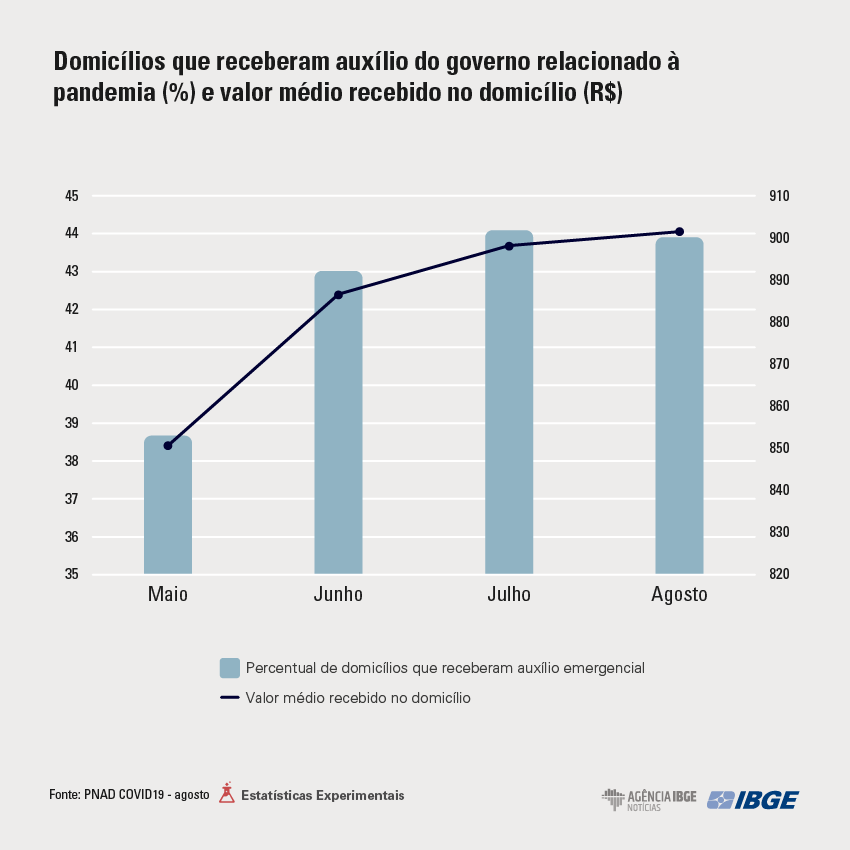PNAD COVID19
A total 17.9 million persons had been tested for Covid-19 by August
September 23, 2020 09h00 AM | Last Updated: September 28, 2020 12h50 PM
Highlights
- 17.9 million persons had been tested for Covid-19 up to August, which is equivalent to 8.5% of the country's population.
- The biggest percentage of testing was recorded among persons with the highest income: 21.7% had been tested in the income range of more than 4 minimum wages and less than 5% among persons earning up to 1/2 a minimum wage.
- Among tested persons, 3.9 million (21.6%) were diagnosed with Covid-19. In July, they amounted to 2.7 million.
- The Federal District (19.4%) was the Federation Unit with the biggest percentage of tests, followed by Piauí (14.4%) and Roraima (12%). Pernambuco had the smallest (5.8%).
- In August, 12.1 million reported some type of flu-like symptom, a total 5.7% of the population.
- The percentage of housing units in the country receiving some financial aid to fight the pandemic was 43.9%, with the highest figures recorded by the North (61%) and Northeast (59.1%).

The number of persons tested for Covid-19 increased by 34.4% in August against the previous month, and reached 17.9% million persons, a total 8.5% of the country's population. Last month, the survey investigated this topic for the first time and showed that 13.3 million persons had been tested by July. Among all the persons tested in August, 21.6% were diagnosed with Covid-19, amounting to 3.9 million persons. The data is from the monthly edition of PNAD COVID19, released today (23) by the IBGE.
“A bigger availability of tests and, consequently, bigger access to them by part of the population may account for the increased number of persons now being tested. Since the pandemic is not over, that figure is intended to increase, even among persons who had no symptoms, but who were in contact with someone once infected with Covid-19 and who were tested in order to make sure,” the survey coordinator, Maria Lucia Vieira, says.
The percentage of testing for detecting the disease is highest among persons with higher earnings, and reaches 21.7% in the group of per capita household earnings of up to four minimum wages and was below 5% among persons who earn up to half a minimum wage. “Whoever has the chance to be tested will do it in labs. There is no indication that higher income ranges are more infected than others, but we know this group has the majority of persons being tested,” the researcher says.
The survey approaches three types of tests: swab, in which material is collected from the mouth and/or nose; the fats finger prick test; and the test of blood taken from a vein in the arm. Among the 17.9 million persons tested, 6.9 million had the swab test, and 25.2% of them tested positive.
The Federal District (19.4%) was the Federation Unit with the highest percentage of testing, followed by Piauí (14.4%) and Roraima (12%). “Among the 19.4% tested in the Federal District, only 4.1% tested positive. So this data shows more persons are being tested compared to those being diagnosed with the disease,” Ms. Vieira says. Pernambuco (5.8%), Acre (6%) and Minas Gerais (6.1%) had the lowest percentages of testing.

In spite of the increase in the number of persons tested, those reporting flu-like symptoms recorded a decrease. In May, 24 million persons reported having at least one of the symptoms mentioned in the survey, such as cough, fever and difficulty to breathe. In August, that figure fell to 12.1 million, which represented 5.7% of the population.
“Persons who were in contact with other that had the disease have more chances of knowing whether they have been infected or not. So many people are tested without having any symptoms,” Ms. Vieira explains.
43.9% of the households received some type of emergency aid.
In August, the percentage of households where at least one of the residents received some type of aid to fight the pandemic was 43.9% in the country, being the highest proportions those in the North (61%) and in the Northeast (59.1%). The average benefit earned by the population was R$ 901 per household.
Among the types of aid dealt with in this survey are the emergency aid, for individual micro-entrepreneurs and informal workers, self-employed persons and the unemployed, and an amount paid by the Federal Government as part of the Emergency Employment and Income Maintenance Program.
Amapá (71.4%) was the state with the biggest proportion of households where one of the residents is a beneficiary of an emergency aid program, followed by Maranhão (65.5%) and Pará (64.5%).
“That index was stable in almost all the states. The total housing units who received some aid had an increase from May to June, but from June to July there was virtually no increase, with stability in August”, the researcher says.




















